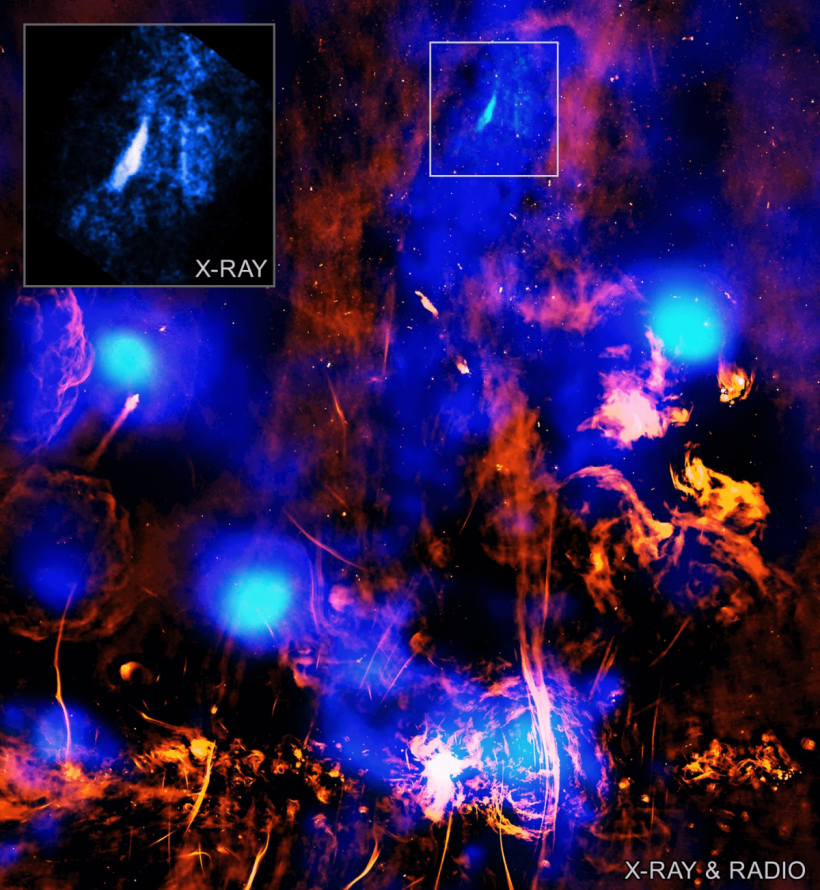NASA's Chandra X-ray Telescope has observed indications of a venting process occurring near the heart of the Milky Way galaxy.
The findings showcase what appears to be an exhaust vent connected to a chimney, ejecting hot gas from the vicinity surrounding the supermassive black hole at the galaxy's center.

(Photo : X-ray: NASA/CXC/Univ. of Chicago/S.C. Mackey et al.; Radio: NRF/SARAO/MeerKAT; Image Processing: NASA/CXC/SAO/N. Wolk)
Venting Activity Near the Galactic Center
In a collaborative effort, X-ray data from NASA's Chandra Observatory has been merged with radio data captured by the MeerKAT telescope, highlighting the presence of this venting activity near the Galactic Center.
NASA noted that researchers previously identified the existence of a "chimney" of hot gas in the Galactic Center thanks to data from Chandra and ESA's XMM-Newton telescopes.
MeerKAT's detection of radio emission offers insights into the role of magnetic fields that enclose the gas within this chimney structure.
The inset image, featuring only Chandra's X-ray data, reveals several bright X-ray ridges that appear perpendicular to the Galactic plane. Scientists believe these ridges represent the walls of a cylindrical tunnel, which functions as a conduit for hot gas, facilitating its upward movement along the chimney and far from the Galactic Center.
Located approximately 700 light-years from the center of the Milky Way, this newly identified exhaust vent is near the top of the chimney.
The image has been rotated 180 degrees to highlight the chimney and exhaust vent features, with the chimney pointing upwards in this reoriented view.
What Caused the Exhaust Vent?
Researchers suggest that the formation of the exhaust vent was likely triggered when rising hot gas encountered cooler gas obstructing its path within the chimney. The bright X-ray emissions observed along the walls are attributed to shock waves generated by this collision.
NASA notes that bright X-ray emissions on the left side of the exhaust vent indicate that the gas flowing upwards strikes the tunnel wall more directly and with greater force than other regions.
The observed hot gas is also believed to originate from a chain of events involving material accreting towards Sagittarius A* (Sgr A*), the supermassive black hole hailing from the Galactic Center.
Eruptions from Sgr A* may have been propelled by the black hole's activity and are thought to drive the ascent of hot gas along the chimneys and subsequently out through the exhaust vent.
The frequency of material accretion onto Sgr A* remains uncertain; however, previous studies have suggested periodic X-ray flares occurring every few hundred years near the black hole's location. These flares could play a pivotal role in propelling hot gas upwards through the chimney vent
Additionally, astronomers estimate that Sgr A* devours a star approximately every 20,000 years, resulting in powerful, explosive ejections of energy that contribute to the dynamics observed in the Galactic Center.
The findings of the study were published in arXiv.
Related Article: NASA's Hubble Space Telescope Captures 'Butterfly Nebula' In Stunning Motion | Fun Facts About This Beautiful Space Butterfly






